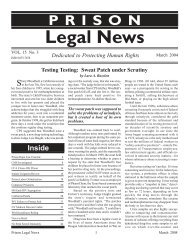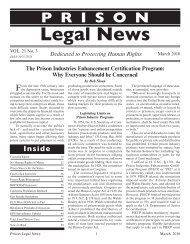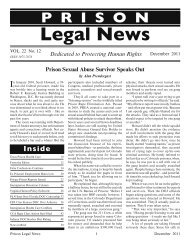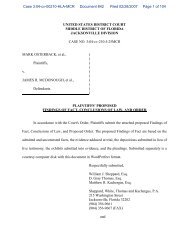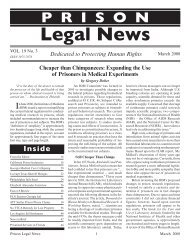From the Editor - Prison Legal News
From the Editor - Prison Legal News
From the Editor - Prison Legal News
You also want an ePaper? Increase the reach of your titles
YUMPU automatically turns print PDFs into web optimized ePapers that Google loves.
April 2008<br />
Oregon Sheriff Sentenced to Jail/Sex-Offender Registration<br />
On August 28, 2007, <strong>the</strong> former<br />
sheriff of Curry County Oregon,<br />
was sentenced to one year in jail and<br />
ordered to register as a sex offender, for<br />
groping three female county employees.<br />
Mark Metcalf spent nearly 25 years in<br />
law enforcement. He was appointed Curry<br />
County Sheriff in 2003, <strong>the</strong>n elected to <strong>the</strong><br />
position by voters in 2004.<br />
In August 2006, Kim Wood, a Curry<br />
County sheriff civil deputy reported that<br />
Metcalf sexually harassed her. A state<br />
investigation was launched, during which<br />
two o<strong>the</strong>r employees––Deputy Tax Collector<br />
Sheryl Luzmoor, and <strong>Legal</strong> assistant<br />
Colleen Wallace––brought additional<br />
accusations against Metcalf.<br />
In June 2007, voters recalled Metcalf<br />
by a margin of 2-to-1. He was <strong>the</strong>n tried<br />
criminally on <strong>the</strong> women’s allegations, in<br />
neighboring Coos County. During <strong>the</strong><br />
trial, at Metcalf’s request, <strong>the</strong> women<br />
testified that he rubbed his body against<br />
<strong>the</strong>irs, touched <strong>the</strong>ir breasts, and slipped<br />
his hand beneath <strong>the</strong>ir clothing. Metcalf<br />
denied Wood’s accusations and claimed<br />
that his conduct with <strong>the</strong> o<strong>the</strong>r women<br />
was consensual.<br />
A six-member jury convicted Metcalf<br />
of eleven misdemeanors: four counts<br />
of third-degree sexual harassment, four<br />
counts of harassment, and three counts<br />
of first-degree official misconduct.<br />
“There was simply no truth to <strong>the</strong><br />
assertion by <strong>the</strong> defense that any of this<br />
conduct was consensual,” said Darin<br />
Tweedt, an Assistant Oregon Attorney<br />
General brought in to prosecute <strong>the</strong> case.<br />
“He was a powerful person in <strong>the</strong> community,<br />
and none of <strong>the</strong>se victims knew how<br />
to protect <strong>the</strong>mselves form him.”<br />
“You chose your power as sheriff to<br />
intimidate, violate, lie and harm,” wrote<br />
Wood in a letter read during Metcalf’s<br />
August 28, 2007 sentencing. “You got<br />
enjoyment from your sick games. I also<br />
know that Sheryl, Colleen and I are not<br />
<strong>the</strong> only women you violated over <strong>the</strong><br />
years. These o<strong>the</strong>r women were too afraid<br />
to come forward. So this is <strong>the</strong> only justice<br />
<strong>the</strong>y will ever get.”<br />
Metcalf faced a maximum of eleven<br />
years in custody. Coos County Circuit<br />
Court Judge Richard Barron elected, instead,<br />
to sentence him to 360 days in jail<br />
and a three-year term of probation. He<br />
also ordered Metcalf to register as a sex<br />
offender, prohibited him from supervising<br />
female employees or contacting <strong>the</strong><br />
victims, and ordered him to give 24-hour<br />
notice before going to <strong>the</strong> Curry County<br />
Courthouse. Following sentencing, Metcalf<br />
was taken into custody.<br />
“I’m very pleased with <strong>the</strong> sentence,”<br />
said Tweedt. “I think <strong>the</strong> judge did <strong>the</strong><br />
right thing and accurately reflected <strong>the</strong><br />
criminal conduct committed.”<br />
Metcalf’s former colleagues weren’t<br />
36<br />
quite so pleased. “Shock, disappointment,<br />
and disgust are <strong>the</strong> three words that sum it<br />
up,” said Dave Burright, executive director<br />
of <strong>the</strong> Oregon State Sheriff’s Association.<br />
“He betrayed not only his own staff, but<br />
<strong>the</strong> people of <strong>the</strong> county and <strong>the</strong> badge<br />
he wore.”<br />
Source: The Oregonian<br />
Washington State Opens<br />
Environmentally-Friendly Control Unit<br />
In October 2007, <strong>the</strong> Monroe<br />
Correctional Complex (MCC),<br />
Washington State’s largest prison, opened<br />
<strong>the</strong> first prison building in Washington<br />
State to be certified as “green” by <strong>the</strong><br />
U.S. Green Building Council. The unit, a<br />
new segregation building with 200 bunks,<br />
consists of a 100-bunk Intensive Management<br />
Unit (IMU) for prisoners who are<br />
placed <strong>the</strong>re at <strong>the</strong> whim of prison officials<br />
for indefinite, long term stays and a 100-<br />
bunk unit for prisoners spending a shorter<br />
period in segregation.<br />
At 2,500-bunks, not including <strong>the</strong> new<br />
segregation building, MCC is Washington<br />
State’s largest prison. Located 45 minutes<br />
from Seattle, overcrowding has long been an<br />
issue at MCC. Relatives of prisoners claim<br />
that <strong>the</strong> crowded conditions led to violence,<br />
including <strong>the</strong> murder of several prisoners.<br />
The new segregation building cost<br />
$39.5 million. The price tag included a<br />
rainwater collection system for toiletflushing<br />
water and low energy lighting.<br />
The Washington State Legislature<br />
passed state laws requiring that new prisons<br />
be energy efficient even though construction<br />
costs of such prisons are higher than those of<br />
conventional prisons. Thus, <strong>the</strong> new “greenrated.”<br />
2,048-bunk prison unit at Coyote<br />
Ridge will cost $254 million. However,<br />
according to Washington Department of<br />
Corrections (DOC) officials, <strong>the</strong> extra cost<br />
will pay for itself in <strong>the</strong> long run by reducing<br />
operating costs. Of course, this assumes<br />
things turn out as planned. PLN has previously<br />
reported on <strong>the</strong> shoddy construction of<br />
o<strong>the</strong>r Washington state prisons that resulted<br />
in millions of dollars of repairs.<br />
“It costs a little bit more to build,”<br />
said David Jansen, head of <strong>the</strong> DOC’s<br />
capital programs. “But over <strong>the</strong> life of <strong>the</strong><br />
building it ends up costing less” in utilities<br />
by Matt Clarke<br />
and maintenance costs.<br />
The new control unit follows <strong>the</strong> typical<br />
pattern of o<strong>the</strong>r Intensive Management<br />
Units in Washington state. <strong>Prison</strong>ers are<br />
locked in <strong>the</strong>ir 8-by-12-foot cells 24-hours<br />
a day, with a nominal one hour of “recreation”<br />
outside <strong>the</strong> cell five days a week.<br />
They are allowed 15-minute showers three<br />
times a week. <strong>Prison</strong>ers are observed 24<br />
hours a day from an elevated, hi-tech control<br />
room and <strong>the</strong> 172 security cameras,<br />
placed throughout <strong>the</strong> 77,000-square-foot<br />
building. <strong>Prison</strong>ers are limited to six<br />
months in <strong>the</strong> segregation unit, but can stay<br />
in IMU indefinitely. The only difference in<br />
how <strong>the</strong> two are run is that IMU prisoners<br />
are allowed a TV and a radio.<br />
Allison Parker, deputy director of<br />
Human Rights Watch, described solitary<br />
confinement as “cruel and unusual punishment.”<br />
“Solitary confinement has <strong>the</strong> obvious<br />
effect of reducing social contacts<br />
between offenders ... and can have lasting<br />
psychological effects on human beings,”<br />
according to Parker. “It should be a measure<br />
of last resort.”<br />
Unfortunately <strong>the</strong> DOC and many<br />
o<strong>the</strong>r prison systems, use solitary confinement<br />
as <strong>the</strong> preferred option for prisoners<br />
who don’t kowtow to <strong>the</strong> system. In addition<br />
to confining some incorrigibly violent<br />
or vulnerable prisoners, it is often used<br />
to discourage prisoner journalists and<br />
jailhouse lawyers from exposing <strong>the</strong> evil<br />
inherit in <strong>the</strong> American way of imprisonment.<br />
PLN editor Paul Wright observed<br />
that during his imprisonment he wound<br />
up in many of Washington state’s IMUs<br />
in retaliation for his writing and litigation.<br />
“Built at great expense, Washington fills<br />
its IMUs with prisoners accused of minor<br />
offenses and <strong>the</strong> mentally ill,” Wright<br />
<strong>Prison</strong> <strong>Legal</strong> <strong>News</strong>



